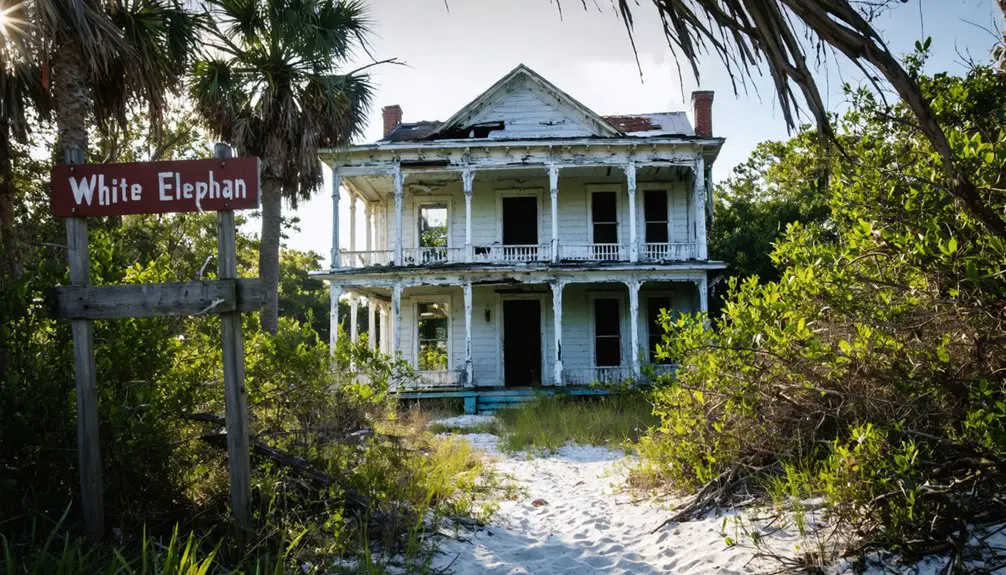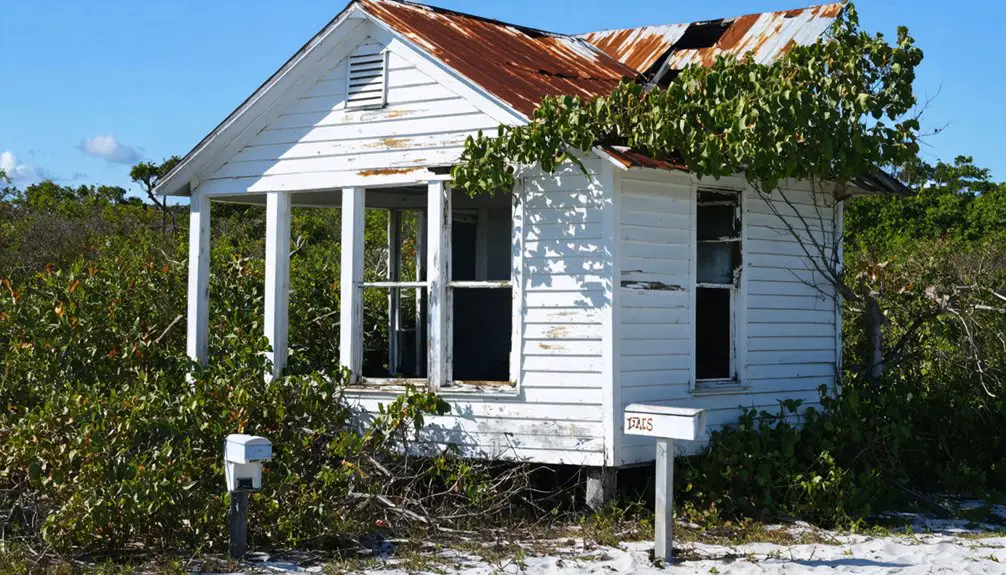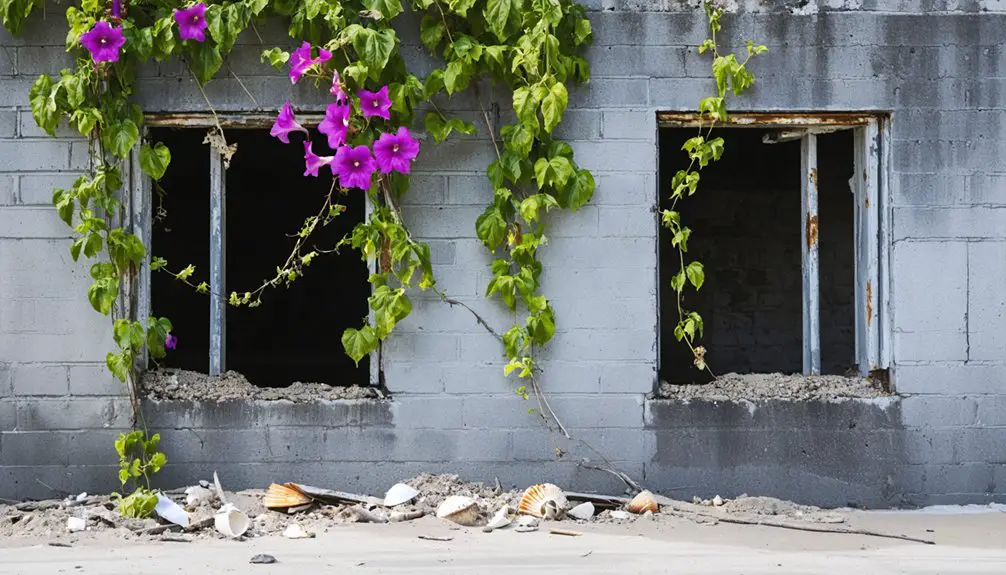You won’t find Englewood, Florida completely abandoned, but it does transform into a near-ghost town during off-season months. When winter residents head north, many local businesses temporarily close their doors, and the vibrant coastal community grows quiet. This seasonal rhythm has defined Englewood since its founding in 1896, with the historic White Elephant building standing as a symbol of the town’s resilient spirit through economic shifts and cultural changes.
Key Takeaways
- Englewood itself is not a ghost town, but is surrounded by abandoned 19th-century settlements like Orange and Espanola.
- Seasonal population fluctuations create ghost town-like conditions during summer months when businesses close and tourists depart.
- Former settlements near Englewood succumbed to hurricanes, economic shifts, and transportation changes, leaving only ruins and markers.
- Historic structures like Kerr City and remains of Jessamine serve as unofficial attractions for those interested in ghost towns.
- The region’s ghost towns originated from failed agricultural ventures, particularly after the devastating freeze of 1894-1895.
The Origins of Englewood’s Settlement
While the Calusa people originally inhabited the region, Englewood’s pioneer settlement began in earnest when William and Mary Goff purchased 60 acres along Lemon Bay in 1878.
The area’s development accelerated after the Nichols brothers officially platted and named the town in 1896, drawing inspiration from their Illinois hometown.
The Nichols brothers brought their Illinois roots to Florida, shaping Englewood’s identity through careful planning and hometown nostalgia.
Early pioneer settlements relied heavily on maritime access, with Buchan’s Landing serving as a crucial supply point since the town lacked connecting roads.
The heart of community organization centered around Dearborn Street, where the Buchans operated the supply business and post office by 1912.
You’ll find the town’s early economic foundation was built on fishing, farming, and lumber industries, with social life flourishing around the Chadwick Pavilion, which served as a bathhouse, store, and gathering place.
The Lemon Bay Historical Society works to preserve these pioneering stories through various educational programs and community events.
The community remained primarily agricultural until the 1940s, when improved transportation and development began transforming the landscape.
From Citrus Groves to Tourist Haven
Early Englewood pioneers envisioned a prosperous future in citrus cultivation, with the Nichols brothers leading an ambitious venture of 2,000 acres dedicated to lemon groves.
But harsh weather and disease crushed these dreams, forcing a dramatic change in the community’s economic foundation. The great freeze of 1894-1895 was particularly devastating for Florida citrus growers.
As citrus decline set in, you’d have found locals turning to the bountiful waters of the Gulf Coast, just as the indigenous Calusa and Timicua had done centuries before.
This fishing shift proved essential for survival, maintaining the town’s liveliness until a new chapter emerged. The area’s rich history includes the Englewood Post Office, established in 1895 as one of the oldest postal facilities on the Gulf Coast.
By leveraging its coastal charm, Englewood transformed into a vibrant tourist destination.
Where lemon trees once stood, you’ll now find vacation homes and resorts, while the Gulf waters continue providing both recreation and livelihood for residents and visitors alike.
Historic Landmarks and Social Hubs
As Englewood matured beyond its citrus-growing roots, several historic landmarks emerged as essential community anchors, with the White Elephant building standing as perhaps the most significant.
You’ll find this structure’s evolution mirrors Englewood’s own transformation – from a simple bathhouse to Lou Woods Casino, and later the Captain’s Club, reflecting the community’s changing identity through the decades.
While many historic gathering spots have vanished, like Woodmere’s bustling sawmill town with its 1,200-person dining hall, the spirit of community preservation lives on.
The White Elephant remains a symbol of Englewood’s resilience, adapting from its early days as the Chadwick Pavilion to today’s cherished landmark.
These social hubs, whether lost to time or still standing, helped shape the town’s character through dancing, dining, and daily connections, with modern establishments like Danny’s Ice Cream continuing this legacy of community gathering spaces.
The town’s coastal beauty draws visitors to its shores, even as it grapples with complex social challenges that shape its modern identity.
Seasonal Ghost Town Status
You’ll notice a stark transformation in Englewood during off-peak months when many businesses shutter their doors and the streets become eerily quiet.
The summer and hurricane seasons hit local establishments particularly hard, with some closing for weeks or months at a time due to both weather concerns and drastically reduced customer traffic. Many residents now live in temporary camper homes while awaiting repairs to their hurricane-damaged houses. Local business owners report this as their slowest summer since 2020.
Winter brings welcome relief as seasonal residents and tourists return, breathing life back into the community and providing essential revenue for the businesses that managed to weather the quiet period.
Off-Season Business Closures
While Englewood thrives during peak tourist seasons, the town transforms into a partial ghost town during off-seasons, particularly after recent hurricanes Helene and Milton forced widespread beach closures.
You’ll find local businesses struggling to survive as the off-season impact intensifies. Hotels that once bustled with winter tourists now see empty rooms every other day, while restaurants and shops fight to keep their doors open. SunLife Beach Hotel reports significant booking declines since the closures.
The situation’s particularly dire since beach access restrictions have pushed visitors to seek alternative destinations. Small family businesses face mounting pressure from high rental costs and insurance premiums.
The town’s business survival now hinges on creative solutions, including temporary facilities and limited beach access points. You’ll notice some establishments reducing hours or closing entirely, while others adapt by promoting alternative attractions.
It’s a challenging balance between maintaining safety standards and preserving the local economy‘s lifeblood.
Population Shifts During Winter
Three distinct seasons define Englewood’s population rhythm, with winter bringing a dramatic transformation from ghost town to bustling community.
You’ll witness a remarkable seasonal migration as snowbirds escape the northern frost, turning quiet streets into vibrant gathering spots. The population dynamics shift dramatically when temperatures up north plummet, bringing retirees who breathe life into local businesses and community spaces.
- Winter months (December-March) see the population swell with seasonal residents, primarily retirees.
- Average winter temperatures of 70°F create perfect conditions for outdoor activities.
- Coastal areas experience the highest concentration of seasonal residents.
- Local businesses adjust their operations to serve the increased winter population.
This cyclical pattern shapes Englewood’s character, with winter bringing energy and significance to the community’s shores and streets.
The White Elephant’s Legacy

You’ll find the White Elephant’s legacy deeply woven into Englewood’s social fabric, transforming from the Chadwick’s modest 1930s beach pavilion into a three-story entertainment complex after the 1945 fire.
Through multiple owners and renovations, the historic building evolved from simple changing rooms and a grocery store into a vibrant hub featuring restaurants, bars, boat docks, and dance floors that drew both locals and tourists.
The White Elephant stands today as a symbol of Englewood’s growth from pioneer village to resort town, having served generations as a cherished gathering place for dining, dancing, and coastal recreation.
Historic Seaside Entertainment Hub
Standing as a proof of Englewood’s vibrant coastal heritage, the White Elephant emerged in the early 1900s as the community’s premier entertainment destination.
Originally known as Chadwick Pavilion, this seaside architecture masterpiece evolved from a carnival-style resort to a three-story landmark that’s shaped local culture for generations.
You’ll discover the rich history of entertainment evolution through:
- The original Chadwick family’s vision of a waterfront carnival and seafood spot
- Lou Woods’ 1945 transformation into a modern restaurant and bar complex
- Clayton Kesselring’s 1958 addition of boat docks and the Captain’s Club era
- The venue’s enduring role as Englewood’s social hub, combining dining, maritime access, and beachfront entertainment
Today, the White Elephant stands as a symbol of Englewood’s enduring connection to coastal living and community gathering.
Building’s Architectural Evolution
From its humble beginnings as the Chadwick Pavilion to its current status as a three-story landmark, the White Elephant’s architectural journey mirrors Englewood’s transformation from a quiet coastal town to a thriving entertainment destination.
You’ll find the building’s architectural significance reflected in its evolution from Pete Buchan’s simple two-story structure to Lou Woods’ ambitious three-story design that defined the post-war era.
The building’s adaptability speaks volumes about its role in shaping community identity.
What started as a basic commercial space with upstairs living quarters has grown into a mixed-use venue featuring restaurants, bars, and waterfront amenities.
Today’s restoration efforts honor this legacy while promising to complete the unfinished third floor, ensuring the White Elephant remains a symbol of Englewood’s architectural heritage.
Community Gathering Place Legacy
Beyond its architectural significance, the White Elephant has served as Englewood’s beating heart since its inception as the Chadwick Pavilion.
You’ll find a rich tapestry of community traditions woven through its history, from weekend dances to carnival gatherings, reflecting the town’s evolving social fabric.
- As Chadwick Pavilion, it provided essential services for beachgoers, including dressing rooms and showers.
- During the Lou Woods Casino era, it became the center of nightlife with gambling and social gatherings.
- The building served as a crucial hub for fishermen, offering bait, tackle, and supplies.
- Today’s White Elephant continues this legacy of communal engagement through live music and waterfront dining.
The venue’s enduring role as a gathering place has helped maintain Englewood’s sense of community through decades of change.
Neighboring Ghost Towns and Lost Communities

While Englewood itself maintains a vibrant community today, the surrounding region tells a different story through its collection of ghost towns and lost settlements.
You’ll find fascinating ghost town origins in places like Orange and Espanola, where 19th-century pioneers once built thriving communities around agriculture and railroads. The cultural significance of these abandoned places reveals itself through preserved structures in Kerr City and the haunting remains of Jessamine.
These lost communities succumbed to various challenges – from devastating hurricanes to economic shifts and transportation changes.
Today, you can explore their scattered ruins, Native American burial grounds, and historic markers that dot the landscape. Many of these sites have become unofficial attractions for history enthusiasts seeking to understand Florida’s pioneering past.
Economic Shifts and Cultural Transformations
The ambitious vision of Englewood’s founders to establish a thriving lemon industry in the 1890s quickly evolved into a tale of resilience and adaptation.
When harsh winters destroyed their crops, you’ll find that the community demonstrated remarkable economic resilience by pivoting to tourism and natural resource-based industries.
- The Nichols brothers built the Englewood Inn and general store, laying groundwork for tourism.
- Peter Buchan’s establishment of a central dock transformed Dearborn Street into a crucial trade hub.
- The shift from isolated farming to fishing and lumber showcased the community’s adaptability.
- Cultural preservation remained strong even as modern development arrived in the 1960s.
Today, you’ll see how Englewood’s economy thrives through a balanced approach of tourism, retirement communities, and waterfront development while maintaining its cherished “Old Florida” character.
Frequently Asked Questions
What Were the Average Land Prices During Englewood’s Initial Development Phase?
You’ll find early real estate and land value trends were modest, with lots likely selling in the low hundreds of dollars during 1896-1910, reflecting limited infrastructure and the collapse of lemon grove prospects.
Did Any Notable Crimes or Gangster Activity Occur at Lou Woods Casino?
While you might expect gangster tales at Lou Woods Casino given its gambling history, there’s no documented evidence of notable crimes or organized crime activity during its operation as a social entertainment venue.
How Many Original Nichols Brothers’ Buildings Still Exist in Englewood Today?
You won’t find any original Nichols Brothers’ buildings standing in Englewood today. Despite their important legacy in founding the town, historic preservation wasn’t prioritized, and fire, development, and time claimed their structures.
What Native American Tribes Inhabited the Englewood Area Before Settlement?
The Calusa were the primary Native tribe in your area’s rich cultural heritage, dominating the coast from Tampa Bay to the Florida Keys. They’d mastered coastal living through fishing, trade, and building complex settlements.
When Did the First Paved Roads Reach Englewood and Connect to Nearby Communities?
You’ll find Englewood’s paved road history began in the 1920s, when commissioner Peter Buchan championed the first paved connections to Sarasota, followed by McCall Road’s extension to El Jobean in 1928.
References
- http://www.gribblenation.org/2019/01/ghost-town-tuesday-vineland-florida.html
- https://lemonbayhistory.com/englewood-history/
- https://www.sarasotamagazine.com/news-and-profiles/2015/06/a-look-back-at-englewoods-historic-dearborn-street
- https://www.youtube.com/watch?v=15no1jbtakU
- https://www.sarasotahistoryalive.com/index.php?src=directory&view=history&srctype=detail&back=history
- https://www.englewood.oh.us/DocumentCenter/View/311/History-of-Englewood—Long-Version-PDF
- https://floridahistory.org/englewood.htm
- https://www.florida-backroads-travel.com/englewood-florida.html
- https://www.pureflorida.com/blog/post/explore-the-history-of-charlotte-county-must-visit-historical-sites/
- https://dos.fl.gov/historical/museums/historical-museums/united-connections/foodways/food-cultivation-and-economies/the-citrus-industry-in-florida/



